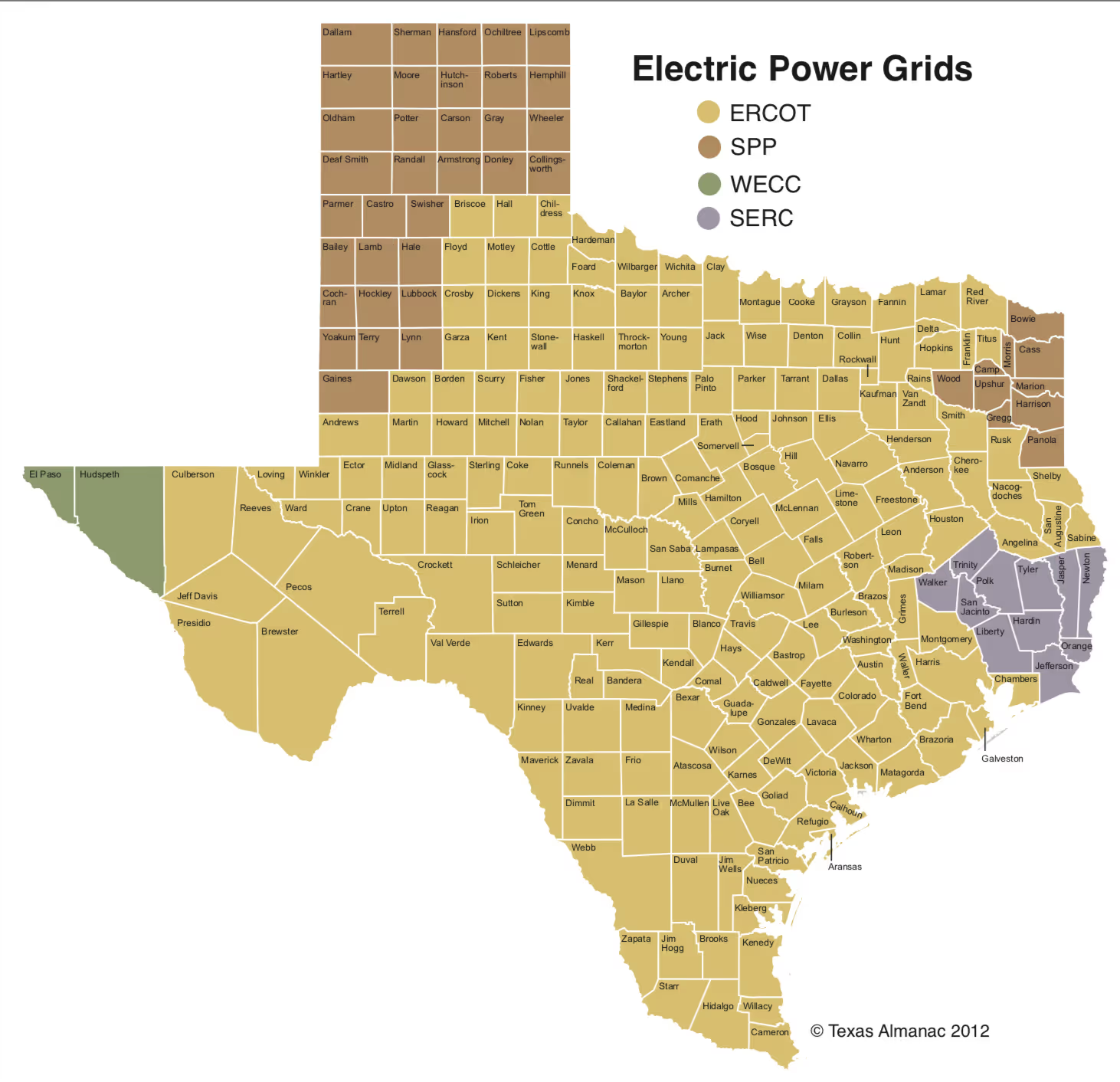Why You Should Pay More Attention to Texas Interconnection and Its Power Grids
Written by

Published on
February 16, 2023


Table of contents
The Texas Interconnection is a minor grid that covers much of the state of Texas. It is a wide-area synchronous grid maintained separately for political reasons rather than precisely due to technical necessities. However, the Texas Interconnection draws power at times from other grids. Similar minor interconnections include Quebec Interconnection and the Alaska Interconnection.
The grid has a network of 550 generation units and 46,500 miles of transmission lines. The interconnection is often overburdened during summers when people use air-conditioning to cool their homes and businesses. In February 2021, record-low temperatures caused disruptions to power production, and Texas Interconnection could not meet customer demand. This led to blackouts that affected more than 4 million people.
The flow of electric power on the Texas Interconnection is managed by Electric Reliability Council of Texas (ERCOT). ERCOT is the first American independent system operator (ISO). There are no other ISOs across North America.
In this article, we look at
- What Texas Interconnection is
- Who supplies and transmits energy to customers
- Why understanding Texas' unique power grid is essential for successful infrastructure development.
Map of Texas Electric Power Grids
To ensure a consistent bulk power supply, four councils were formed in 1968. The electric grid map briefly looks like this:

- ERCOT supplies power to 75% of the state and covers much of the central and southern part of Texas.
- Southwest Power Poolsupplies power to the regions of South Plains, the Panhandle, and a small area in the Northeast of Texas.
- Western Electric Coordinating Council (WECC) supplies power to certain areas of Trans Pecos and El Paso.
- Southeast Texas is served by Southeastern Electric Reliability Corporation (SERC).
To carry out infrastructural projects in Texas, it is essential to have the latest and most accurate electric power grid maps. However, the above map is not very accurate, and the boundaries of the four power grids can spill beyond county borders. It is also crucial to understand which council has jurisdiction over the utilities to avoid conflicts.
Texas Electric Grids: Demand and Supply
Many people are moving to Texas, necessitating building new cities. As new towns and communities are built, ERCOT often has to take the brunt and provide energy to these new customers. For instance, when the city of Lubbock joined the ERCOT grid, an astounding 83,000 consumers were transferred to the ERCOT over a weekend on May 29th and 30th of 2021.
Hence, energy demand and supply are significant issues when discussing large infrastructural projects such as building new communities and cities.
Where does Texas get its power from?
According to ERCOT, which supplies power to 90% of the state and 26 million customers, a large portion of energy comes from natural gas.
- In 2020, 45.5% of electricity came from natural gas.
- The second most important source of power in Texas is wind, which accounts for 22.8% of electricity on Texan grids.
- Coal makes up only 17.9% of power sources, and the state is gradually moving away from fossil fuels to adopting cleaner and greener energy sources.
- Nuclear power supplied 10.9% of energy to Texans in 2020.
Minor sources of electricity include landfill gas, solar energy, hydroelectric power sources, biomass, net DC-tie, etc.
Why Does Texas Have Its Own Independent Power Grid?
One of the reasons why Texas Interconnection is maintained independently is to ensure that it does not have to comply with Federal Energy Regulatory Commission (FERC) regulations. However, the reasons are more cultural than evading federal law. Texas has always had a strong regional identity and has believed in federalism, which curtails the power of central agencies.
With that in mind, it becomes amply clear why Texas chooses to have its power grid. Moreover, Texas has abundant natural resources such as natural gas, wind power, and solar energy. This allows it to be self-reliant most of the time. However, there are times when the state needs to borrow energy from other agencies.
Who Controls the Texas Electric Grid?
Although ERCOT supplies 90% of electricity in Texas, it is regulated by the Public Utility Commission of Texas (PUCT) and the Texas Legislature. In addition to ERCOT, the Western Electric Coordinating Council (WECC), the Southeastern Electric Reliability Corporation (SERC), and the Southwest Power Pool (SPP) control the supply of power to a smaller extent.
How much energy does the Texas power grid generate?
On average, Texan homes use 1,176 kWh per month (14,122 kWh per year). With an installed capacity of almost 133,000 megawatts in June 2021, Texas is nearly self-sufficient to meet its demands. To put things in perspective, in 2020, the state generated 473,880 gigawatt-hours of electricity.
Although Texas is virtually self-sufficient in supplying power to its citizens, more is needed. Malfunctions at power plants, higher consumption of energy during extreme weather conditions, and electrical faults within the grids can all contribute to power supply issues.
How secure is the Texas power grid today?
In general, the Texas power grid is quite secure. However, as people and businesses tend to use air conditioners extensively in August, ERCOT sometimes faces difficulties. The Texas grid was also unprepared for the 2021 winter storm, resulting in peak electricity consumption due to heaters being turned on and people staying at home. This too resulted in power sources failing.
While some people blame certain deaths at hospitals on this disruption, it is unclear if one can blame the Texas power grid directly. Nevertheless, the Texas grid needs to prepare to meet extensive energy demand, especially when the demand arrives in sharp bursts.
If your organization sets out to begin any sort of project, you can expect trouble from various energy players unless you understand the scenario accurately.
How is the Texas power grid different from all other states?
As stated before, Texas is the only state in the US with its own power grid. This means the state can legislate laws outside the purview of FERC. In addition to having its own power grid, Texas' energy market is different too.
Energy generators do not transmit or distribute power. They sell it to retailers who resell it to end users. Distribution and transmission are taken care of by other agencies. We discuss this in the next section.
The Working Parts of the Texas Power Grid
In most places, power grids transmit and distribute energy to end users in addition to generating electricity. However, in Texas, the grid operates quite differently. Power generators sell energy to retail electricity providers (REP) in bulk. REPs, in turn, resell power to businesses and homes.
The price of electricity in Texas is dynamic and is dependent on market factors such as demand and supply. Hence, to make the best use of market dynamics, REPs offer different electricity plans to customers. While some plans have a fixed rate, others can vary. Customers also have the option to prepay their energy usage.
REPs and power generators neither maintain nor control power lines and transformers. Companies like CenterPoint and Oncor take care of the actual transmission and distribution of electricity. No matter which REP provides energy to businesses and homes, the final invoice will carry a passthrough charge levied by the local transmission and distribution utilities (TDU).
Make sure you have access to electric utilities map before starting any project
In Texas, multiple entities generate, resell, distribute, and transmit electricity. Infrastructural projects must liaise with various energy-associated entities before beginning any project. Access to a grid map and the exact position of transformers and wires can help infrastructure contractors avoid damage and lethal accidents.
4M's utility maps are immaculate and help you understand precisely under whose jurisdiction your project falls. You will not have to deal with utility conflicts that may arise when different energy providers overlap within the same community. In addition, you will also not miss taking into account the infrastructure laid by energy generators, power distributors and transmitters, and REPs.
To understand how our maps help you get a clear picture of Texas' power grids and Interconnection, contact us today.
Recent blog posts

Our Newsletter
Join 7k infrastructure professionals
Get monthly insights on ways to build smarter, faster and safer with Utility AI.



.avif)

